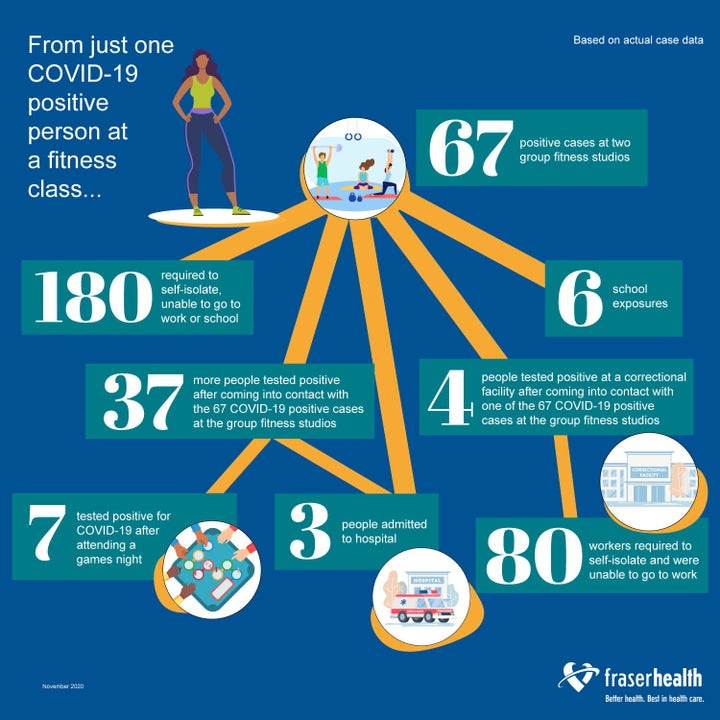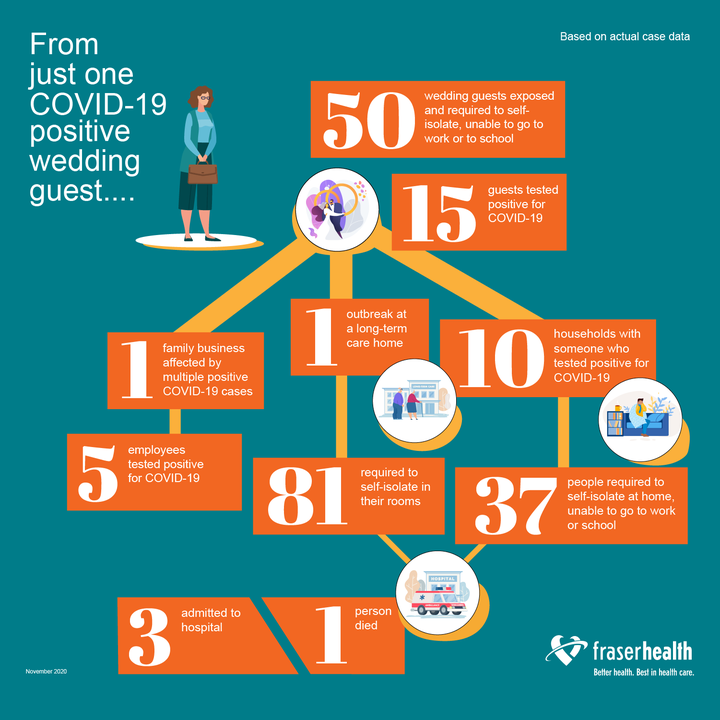We all know that gatherings are risky for spreading COVID-19, but how big of a risk are they?
In an ad campaign released this week, officials from Fraser Health — British Columbia’s largest regional health authority — break down how one COVID-19 case in a group setting can balloon into many more.
Using real data compiled by contact tracers in the region, the graphics show how a single case at a fitness class, a wedding or an industrial worksite can multiply.
The region is currently home to the vast majority of new cases in B.C., accounting for nearly twice as many total cases as any other health authority in the province. As of Nov. 11, the region that covers the areas immediately south and south-east of Vancouver has more than 3,500 of B.C.’s 5,133 active cases.
Here’s how three different situations led to dozens of new cases.
A fitness class

In the case of a fitness class, one person with COVID-19 who attended a fitness class led to 67 positive cases across two fitness classes. 180 people were required to self-isolate because of potential exposure, as well as exposure alerts at six different schools.
An additional 37 people tested positive for COVID-19 after coming in contact with the fitness class participants. Seven more tested positive at a games night and at least three people linked to the outbreak were hospitalized.
The fitness class outbreak also led to four people testing positive at a nearby correctional facility after a staff member came into contact with one of the fitness class attendees. As a result, 80 workers at the facility were required to self-isolate.
A wedding

One positive COVID-19 patient who attended a 50-person wedding led to 15 other guests from 10 different households testing positive in subsequent days.
It also led to an outbreak at a long-term care home, where 81 people were required to self-isolate. At least three residents were admitted to hospital, and one died.
A workplace

One COVID-19 positive employee at an industrial worksite in the region led to 48 other cases from the same worksite, with one worker admitted to the hospital.
At least seven other cases were linked to contact with the infected workers, prompting alerts at four other worksites including a car dealership, medical clinic, lumber mill and processing plant. In total, at least 46 households were affected, and 111 people had to self-isolate.
New regional restrictions
As regions across Canada introduce new restrictions to prevent the surging second wave of COVID-19, the graphics are part of a push to dissuade people from gathering in social groups.
Fraser Health is included in a recent health order from B.C.’s chief medical officer Dr. Bonnie Henry banning social gatherings outside of your immediate household, as well as group fitness classes and wedding and funeral receptions, for the next two weeks.
The goal is to prevent superspreader events just like the ones described in the graphics.
“It is a short-term pause on non-essential activities and travel to ensure that our essential activities like school and work and health care can safely continue,” Henry said Monday.
Officials from Fraser Health said they will be translating the graphics into Punjabi and other languages in an effort to reach the region’s various cultural groups.